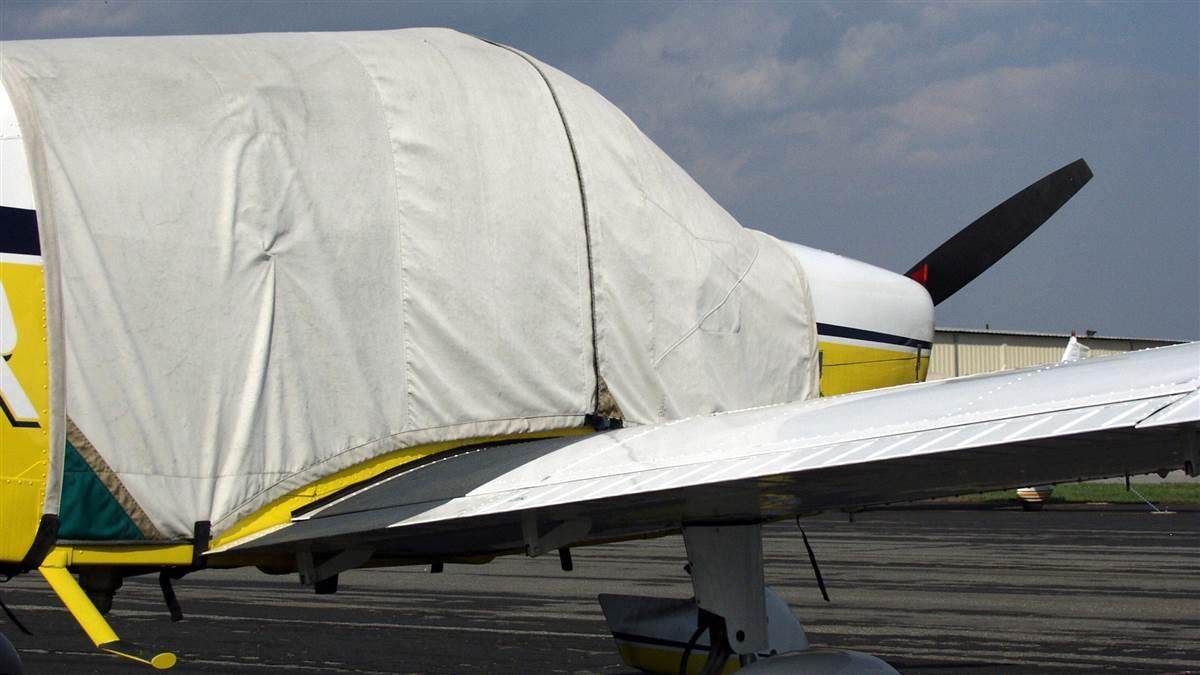Aging Aircraft - Boeing participated in the Airworthiness Assurance Working Group (AAWG) to establish a method of compliance that could be broadly supported by all stakeholders. The AAWG developed the initial draft of the FAA's advisory circular for this rule, AC 120-93.
Boeing continues to participate in the AAWG to enable resolution and awareness of compliance issues at an industry level throughout the implementation of this rule. The first thing a first-time aircraft owner must do is register the aircraft in his name with the FAA.
Aging Aircraft

FAR 47.31 states no one can operate an aircraft until it is registered. FAR 47.31 tells how to apply for a certificate of registration, and specifies that when the FAA sends the permanent registration, the owner must keep the document in the aircraft.
Importance To Members
As the registered owner of an aircraft, FAR 91.403 makes you responsible for maintaining the aircraft in an airworthy condition. This includes complying with all FAA airworthiness directives (ADs) issued for your aircraft, engine, and equipment.
Also, aircraft owners must notify FAA of any change in permanent mailing address, the sale or export of the aircraft, or the loss of eligibility to register an aircraft (see FAR 47.41). Long-term, however, the Air Force is increasingly embracing the idea of using space-based assets for both airborne surveillance and ground moving-target indication (GMTI) missions, a concept you can read more about here.
How realistic that ambition is, remains to be seen. In the meantime, the E-7 is now in a good position to one day become the backbone of the USAF's airborne early warning and control force. One way the FAA keeps owners, mechanics, and pilots current on required maintenance issues is with the Airworthiness Directive, or AD.
It's important and has its own part in the FARs, which usually isn't included in commercial compilations of the regulations. Briefly, Part 39 says that we cannot operate an aircraft to which an AD applies unless we comply with the requirements of that AD.
Other inspections are required for the instruments and equipment installed in the aircraft. However, some of these inspections are only required if the aircraft is operated under instrument flight rules. For example, another inspection you should be aware of is the altimeter system and altitude reporting system test and inspection.
This inspection, described in FAR 91.411(a), is required if the aircraft is operated in controlled airspace under IFR. It mandates that within the preceding 24 calendar months, each static pressure system, each altimeter instrument, and each automatic pressure altitude reporting system must have been tested and inspected and found to comply with appendix E of Part 43. Automatic pressure altitude reporting system is just
a fancy name for the mode c transponders altitude encoder. The Aging Aircraft Safety Act of 1991 passed by Congress in 1991 — and later codified by the FAA as the AASR — requires airlines to ensure that repairs or modifications made to their airplanes are damage-tolerant.

As part of the requirement, airlines must have a damage-tolerance-based maintenance program in place by December 20, 2010. This includes the development of an FAA-approved Operator Implementation Plan that contains the processes and timelines the operator will use for obtaining and
incorporating maintenance actions to address the effects of repairs and alterations. Here is how the re-registration process works. All aircraft owners will receive a notification from the FAA, which includes an online re-registration code (to be used for electronic filing), 180 days before the expiration of their current registration.
The notice will give a three-month time frame (see chart below) in which the aircraft owner is able to log onto the FAA website and renew the registration using the re-registration code included in the notice.
Note: The online option is available only if no changes need to be made. Owners have to re-register during the specified three-month window in order to use the electronic option. If an online application has not been processed at FAA by the deadline, an 8050-1 (paper registration application) will need to be completed and mailed to FAA.
The final addition to the rule is "Owner Produced Parts" According to a rules interpretation? the owner must control or participate in at least one of the following functions for the part to be considered owner-made.
He must a) provide the manufacturer with the design or performance data to make the part? b) provide the manufacturer with the materials to make the part; c) provide the manufacturer with fabrication processes or assembly methods to make the part;
d) provide the quality-control procedures to make the part; or e) personally supervise the manufacture of the part. The owner can hire someone, even his mechanic, to manufacture the part if he fulfills the conditions mentioned in the previous paragraph.
As part of an ongoing study of the effects of aging aircraft on Air Force budgets and force planning, RAND Project AIR FORCE developed a mathematical model to calculate how maintenance requirements increase over an aircraft's life.
Preliminary findings include the following: It is often debated whether the guidance offered to pilots in FAA publications such as the Aeronautical Information Manual (AIM) should be considered regulatory. That is, do you need to know and follow these publications just as you are required to know and comply with the federal aviation regulations?

A good means to end this debate is an FAA issued description of the scope of the AIM, and other such publications. "This publication, while not regulatory, provides information which reflects examples of operating techniques and procedures which may be requirements in other federal publications or regulations.
It is made available solely to assist pilots in executing their responsibilities required by other publications.” Such a statement expresses that although they should be taken as guidance and not requirements, a competent pilot in command would adhere to the guidance recommended in the AIM.
"The rapid prototyping program will integrate U.S.-based mission systems into the existing airborne platform to meet DAF [Department of the Air Force] requirements, while simultaneously ensuring interoperability with coalition and allied partners already operating the E-7A," the Air Force said
in a statement. FAR 3:5(a) Statements about products, parts, appliances and materials provides a definition of "airworthy" as follows: (a) Definitions. The following terms will have the stated meanings when used in this section: Airworthy means the aircraft conforms to its type design and is in a condition for safe operation.
With this definition in mind, it is important to understand who is responsible for determining the airworthiness of the aircraft prior to flight. This subject report will discuss this and other information relating to aircraft airworthiness.
The contract had been expected ever since the Air Force determined that the E-7 was "the only platform capable of meeting the requirements for the Defense Department's tactical battle management, command and control and moving target indication capabilities within the timeframe needed to replace the aging
E-3.” This came after plenty of previous discussions about buying the Wedgetail, including from Air Force officials. Once owners have transitioned to the new registration, the new certificates will expire three years from the month in which re-registration was accomplished.
For example, if an owner whose registration expired March 31, 2011, renewed in November, 2010, the three-year registration will display an expiration date of November 30, 2013. The AASR requires operators to have a damage-tolerance-based structural maintenance program for each applicable transport category airplane operated in 14 CFR 121 and U.S.-registered airplanes operated in 14 CFR 129. The requirement extends to the fatigue-critical structure of the baseline,
as-delivered airplane structure, as well as to existing and future repairs and alterations that affect fatigue-critical structure. The rule affects all Boeing 7-series, MD, and DC turbofan-powered transport category airplanes. Operators must comply with this rule by December 20, 2010.

Operators are expected to develop and gain FAA approval of an Operator Implementation Plan that details how the operator will comply with the requirements of the operational rules. This plan will consist of both new and existing operator-specific processes the operator will use in demonstrating compliance, including:
According to the Air Force's 2023 Fiscal Year budget request, the advantages of the MESA include “improved kill-chain effectiveness, enhanced reliability/availability, and reduced operating costs by integrating a modern electronically scanned array sensor on a manned platform.
The electronically scanned array is capable of radar beam steering, sector staring and much faster target revisit rates that translate into better target detection and tracking of modern threats well as more robust electronic protection that isn't possible with the mechanically scanned radar used by E-
3 AWACS.” Finally, in order to operate under IFR using the VOR system of radio navigation, the VOR equipment of that aircraft must have been operationally checked within the past 30 days in accordance with FAR 91.171.
Existing repairs. Existing repairs are defined as those installed prior to December 20, 2010, that affect fatigue-critical structure and do not have approvals indicating a damage tolerance evaluation and the resulting damage tolerance inspections require further action.
Operators are expected to identify and document these repairs via an airplane survey. All airplanes delivered prior to December 20, 2010, will require a survey to determine repairs to fatigue-critical structure that do not have damage tolerance inspections.
The operator's implementation plan will need to define how they will obtain and implement the damage tolerance inspections for these repairs. What is conformity to type certificate? The FAA's attitude has been that an aircraft must be in just about factory-new condition (if it was factory built), plus the alterations must be in the same condition as that when completed in accordance with a supplemental type certificate (if the craft was
altered), plus the aircraft must be in compliance with any applicable airworthiness directives. The next application is parts built to a technical standard order, or TSO. TSOs are minimum standards for the design and production of common parts and accessories.
Altimeters, compasses, instruments, tires, seat belt assemblies, autopilots, aircraft-covering fabric, wheels, and many avionics are examples of TSO-approved items. Items on the MMEL that are not installed in your aircraft are deleted. Equipment in your aircraft but not on the MMEL are added to the list.

When this task is completed, you submit the MEL with a request to the FSDO. The request is usually evaluated by FAA representatives specializing in operations, airworthiness, and avionics. Once the MEL is agreed upon, you and the FAA sign a letter of authorization, which enables you to use the MEL.
Boeing has published new and updated material to help operators comply with this new rule. All Boeing data needed by operators to comply with the new rule is available for purchase on MyBoeingFleet.com, except for customized master-change service bulletins, which are available by request.
Boeing is conducting seminars on this subject. There are many factors affecting an aging aircraft and subsequently the airworthiness of an aircraft, these factors can be categorized as genetic, and non-genetic. Genetic factors are those that cannot be easily controlled, and conversely non-genetic factors can be controlled.
To some degree, exposure to acids, salts, and other contaminants from airborne pollution is genetic. These factors hasten the onset of corrosion. Other genetic factors for each airplane include the normal fatigue cycles that are part of every taxiing, takeoff, cruising, and landing operation.
Published data. Boeing has updated published repair and alteration data for all applicable models to include damage tolerance inspections. This includes structural repair manuals, fleet-support service bulletins, master-change service bulletins, and Boeing-held supplemental type certificates. The damage tolerance inspections for service bulletins have been published in a single service bulletin collector document for each airplane model.
In the future, when individual service bulletins (listed in the service bulletin collector document) are revised, the damage tolerance inspection information will be included in the new release and the information in the collector document will no longer apply.
(Collector documents for master-change service bulletins will be generated upon request and customized to reflect operator-specific configurations. Operators purchase a master-change collector document by submitting a request for proposal to Boeing.) As well as detecting and tracking targets of various types at long range, the E-7 offers Advanced Battle Management System (ABMS) capabilities, critical to the Pentagon's ambition to provide more effective long-range 'kill chains,' which are seen as a
prerequisite of potential future conflicts with peer adversaries, like China. Effective October 1, 2010, aircraft owners are required to re-register their aircraft every three years. The plan calls for the re-registration of all U.S. civil aircraft by December 31, 2013. The FAA re-registration fee is $5.00.
The FAA will cancel the N-numbers of aircraft that are not re-registered or renewed. To ensure that their aircraft do not slip through the cracks, owners should check the FAA website now and make sure the FAA has accurate information regarding their aircraft.
:format(jpeg)/cdn.vox-cdn.com/uploads/chorus_image/image/52213741/624133664.0.jpeg)
In its media release, Boeing states that the E-7 “provides a fully integrated, combat-proven, flexible command and control node that delivers multi-domain awareness in the most challenging operational environments. The E-7's open systems architecture and agile software design enable the aircraft's capabilities to evolve and remain ahead of future threats.”
After the final rule was published, Boeing organized and held five model-specific Structures Task Group (STG) meetings to guide development of the Boeing documents that operators would use to assist them in the development of their implementation plan.
The groups were organized according to AAWG guidelines, and each STG had representation of approximately 60 percent of the active airplanes in a specific airplane fleet. Under FAR 91.409(a), an aircraft must undergo an annual inspection every 12 calendar months to be legal to operate.
If an aircraft is used to carry passengers for hire or is operated for hire (as in flight instruction), it also must have either an annual or 100-hour inspection within the preceding 100 hours of time in service.
It's important to remember that while an annual can serve as a 100-hour inspection, a 100-hour inspection will not substitute for an annual. Remember that for an annual, the period of 12 calendar months extends from any day of any month to the last day of the same month in the following year.
An example of an equipment inspection you should be aware of is the emergency locator transmitter (ELT) entry required by FAR 91.207. This regulation says that the ELT must have been inspected within 12 calendar months after the last inspection.
The ELT is checked for proper installation, signs of any battery corrosion, the operation of the controls and crash sensor, and the presence of a sufficient signal radiated from its antenna. The Airworthiness Concern Process (ACP) is a cooperative information-sharing initiative between industry and the FAA intended to increase industry participation in the development of airworthiness issues before (or in lieu of) a proposed or final airworthiness directive (AD) for an aircraft.
The ACP has been successfully employed for airframe-related concerns for years. As a result of AOPA's efforts, the ACP was expanded to include engine- and propeller-related airworthiness issues. An important element of this official FAA process is AOPA's Advocacy efforts, which serves as a "central hub" for distribution of airworthiness concern sheets to aircraft type clubs, and submission of type club comments to the FAA.
In conclusion in order to be legal and safe to fly, an aircraft must have a current annual, a 100-hour inspection if used to carry passengers for hire or operated for hire, and all applicable ADs must have been complied with.
Depending on how the aircraft is operated, it should also have static system and altimeter, transponder, ELT, and VOR equipment checks. FAR 91.7(a) requires that, "no person may operate a civil aircraft unless it is in an airworthy condition."
Subsection (b) of the same section provides that the pilot in command [PIC] of an aircraft is responsible for determining that the aircraft is in a condition for safe flight, and that the PIC must discontinue the flight when the aircraft encounters unairworthy mechanical,
electrical, or structural conditions. FAR 3:5(a) Statements about products, parts, appliances and materials provides a definition of "airworthy" as meaning the aircraft conforms to its type design and is in a condition for safe operation. Boeing AASR seminar.
Boeing is also conducting AASR seminars focusing on the steps necessary to establish compliance with the new operational rules and the Boeing publications developed to support operator compliance. Availability can be found at http://active.boeing.com/nosearch/svceng/seminars.cfm.
aging aircraft faa, aging aircraft solutions, aging aircraft definition, aging aircraft thesis, aging aircraft program, faa aging aircraft requirements, aging aircraft issues, faa aging aircraft program
0 Comments